A typical organization deals with vast amounts of information and documents: processes, customer data, security policies, and contracts, to name a few. You can’t simply manage all these documents manually — not if you want to stay efficient.
Here’s where document management workflows come into play. Today, we’ll cover exactly what a document management workflow is and how to design and optimize yours to maximize results.
What is a document management workflow?
A document management workflow is the process you use to store, share, delete, edit, categorize, and manage the documents in your organization. The process aims to provide clear guidelines on how to complete a task in the document management life cycle.
For instance:
- Document creation: what steps do you need to create a new document?
- Document retrieval: what can you do in case you accidentally delete or lose important documents?
- Document requests and approvals: how long does it take to approve a new document? What are the steps involved in the approval workflow?
- File sharing: is everyone able to share documents effectively? If so, what does the process look like?
- Document tracking and reporting: what are you doing to make sure your workflows are working properly?
- Document removal: are you keeping tabs on redundant data, such as duplicate files, and are you getting rid of unnecessary files on a regular basis?
Among others.

In other words, document management workflows serve as a map you can follow from the conception of an idea to document delivery.
A typical document management workflow might look something like this:

These workflows are often managed through the use of a document management system (DMS).
DMS are computer programs that provide helpful features for the implementation of a document workflow, including:
- Project management: organize tasks and assign projects to specific team members
- Collaboration features: centralize your communication and collaborate together in a single workspace
- Integrations: seamlessly integrating the tools and apps your team already uses
- Automation: automate repetitive tasks and internal processes in a couple of clicks
- DMS workflow management: manage and oversee all your workflows in a single place
- Data visualization: visualize relevant data about your documents (e.g., usage, document creation, contributions, etc.)
We’ll cover these features in more detail a bit later, but first, let’s answer a crucial question.
Why do you need a DMS workflow?
To understand the importance of document management workflows in modern organizations, let’s imagine that you’re a sales manager in a large SaaS company and you’ve just hired a new sales rep.
This new sales rep needs to learn several processes that are critical for their job.
For instance:
- How to handle sales conversations
- How to communicate your value proposition
- How to use your CRM to oversee the entire sales cycle
And many others.
To learn all these different things, they will need access to specific information and documents. And your document management workflow will dictate how and when this person will receive these things.
A confusing or poorly planned workflow will lead to poor results, as new hires may receive documents in the wrong order, miss out on crucial information, or feel bombarded with too much info at once. And then they won’t be able to implement your processes correctly.
But the workflow doesn’t end with new hire training. Document management is a collaborative process. New hires not only consume information but create it.
As they gain more experience, they might also need to train their peers on the use of specific tools and processes.
All this information will eventually turn into new documentation.
Document management workflows improve the way people access documents, but also build a single source of information for the entire organization.
Other benefits of document management workflows include:
- Reduce organizational chaos: a solid document management workflow will bring more clarity to everyone involved and will help you work more efficiently
- Increase transparency: help team members understand your processes and help them access the right information when they need it
- Train your team: help your team members develop new skills by accessing the right information
- Solve problems faster: when everyone understands your processes, they’re better able to solve business problems
Now that you understand the importance of document workflows, the question becomes: how can you design and optimize yours?
7 ways to optimize your document management workflow in 2022
We came up with some ideas of how to create a seamless process below:
1. Centralization
As we stated a bit earlier, document management needs involvement from your entire organization.
Customers, employees, and stakeholders are continuously producing new information, and they need a clear path of action to document their knowledge.
They also need a way to access the right information, at the right time to solve specific business problems. This is especially difficult for large organizations.
When you’re dealing with hundreds of people and processes, how can you control and manage information and documents? The only solution is to centralize your workspace.
By bringing your entire team to work under one roof, you’re able to improve collaboration and get more control over your documents. Here’s where a Work Operating System (Work OS) comes into play.
The right Work OS can improve the way you collaborate by bringing your entire team together into a centralized workspace and removing silos between departments.
For example, with monday.com, you can invite both internal and external users, communicate in context, and manage all your team collaboration in a single place.
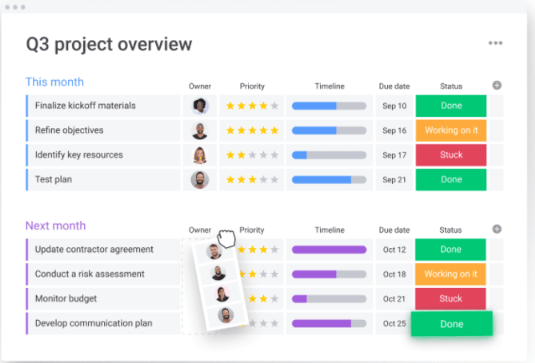
You can also set permission levels to boards so that only the right people can access certain information. Besides, thanks to monday.com’s Activity Log, you can explore the entire history you’ve had with customers, employees, and stakeholders and visualize all the document versions available.
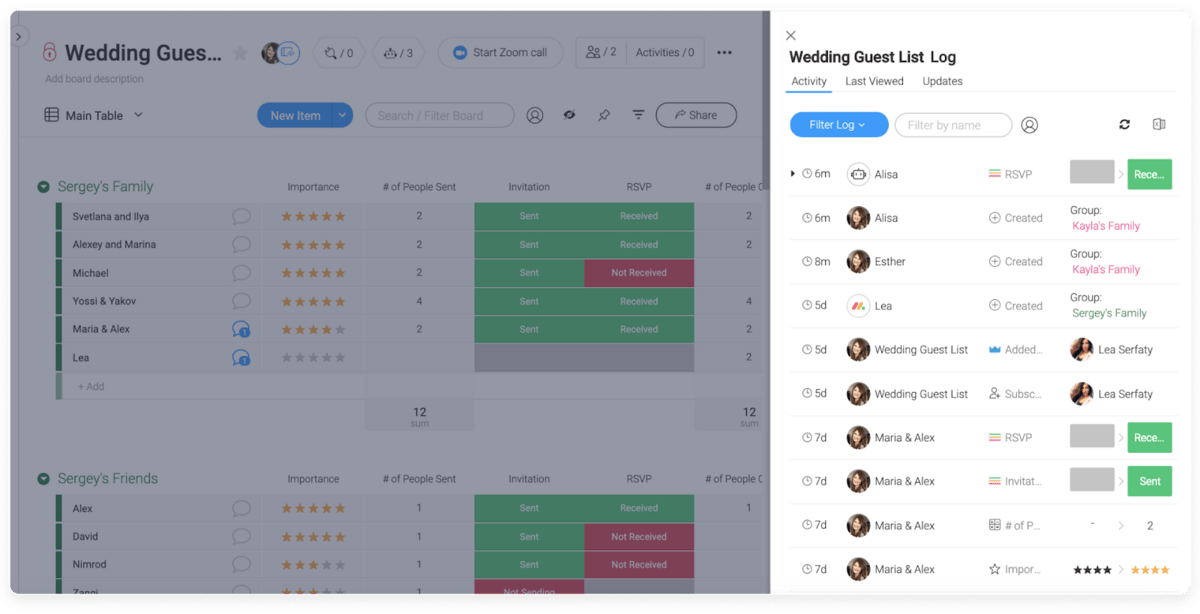
This can improve your document control, as you can oversee what everyone’s doing and get all your team involved in the document management process.
2. Advanced search
Searching through hundreds of documents manually is inefficient.
For example, imagine that you need to find a document you created 5 years ago. Without a powerful internal search engine, the task would be hard, if not impossible.
By categorizing your information based on specific criteria and adding search functionality to your system, you can optimize your document workflow.
With monday.com’s Search Everything feature, you can quickly find any information across your entire account.

Search Everything also comes with advanced filtering options so you can scan through hundreds of documents in seconds and find what you’re looking for with ease.
3. Document retrieval
Losing information accidentally is pretty common among organizations. What if you delete a critical document? What if you lose important documentation about a client or a process?
Before selecting a particular DMS, make sure it offers document retrieval capabilities.

The above Recycle Bin feature from monday.com automatically stores all deleted or archived documents and helps you restore them in just a couple of clicks.
All deleted information will be stored in the Recycle Bin for 30 days unless you decide to delete it permanently.
This will help you quickly retrieve deleted documents and reduce accidental data deletion.
4. Automation
Want to know the fastest way to optimize your document management workflows?
Well, it’s using automation.
Automation can increase productivity and efficiency in your processes literally overnight.
By automating repetitive tasks and processes, you’re able to save time and use it to work on activities that really move the needle.For example, with monday.com, you can automate up to 250,000 human actions, including:
- Task creation: create any type of task-based on specific trigger actions
- Notifications: notify specific team members or clients whenever an action is completed
- Tagging: tag team members, customers, and stakeholders based on conditional data
- Dependencies: set task dependencies automatically and complete your projects on time
- Status changes: change the status of tasks automatically and make sure nothing slips through the cracks
- Recurring activities: streamline repetitive activities and repurpose that time into more productive tasks
- Custom: build custom automation recipes to automate any type of activity
And more.
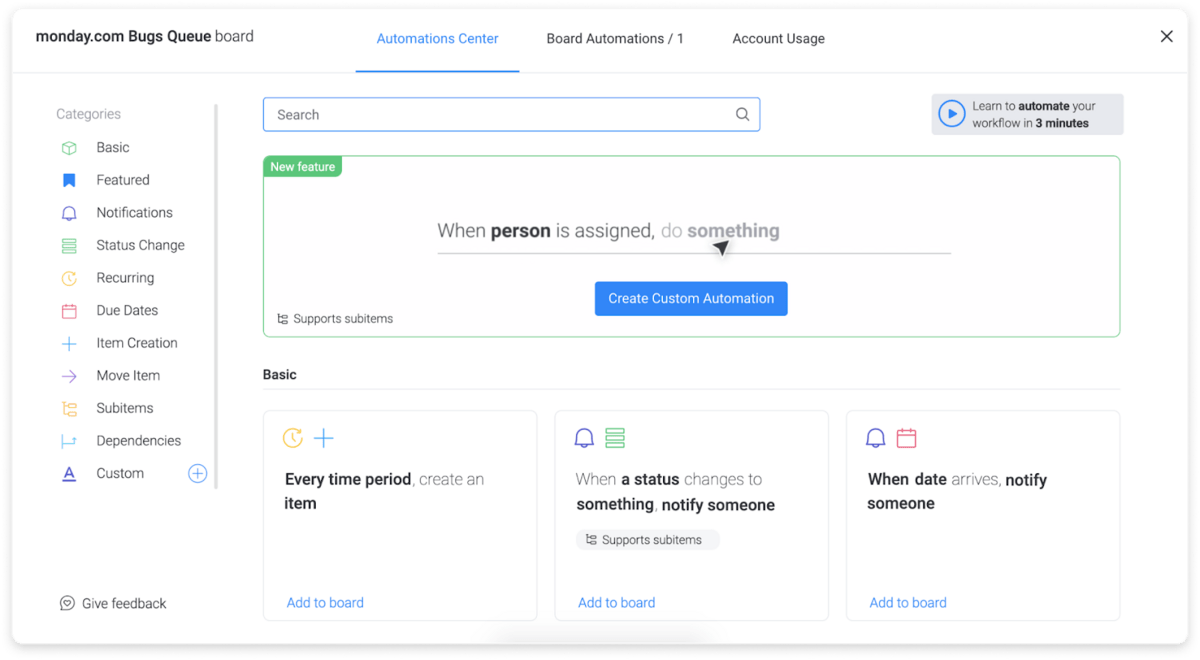
This gives you the flexibility you need to streamline any type of workflow with ease.
5. Document creation and management
To improve your document management workflows, you need a way to create, edit, and brainstorm new documents in the same place.
If your document production process is dispersed across multiple platforms, you’ll struggle with information governance, and you’ll be way less productive.
Look for document management software that helps you create documents with ease and collaborate on projects in real-time.
Their newest building block, workdocs, lets any monday.com user, create and brainstorm new documents.
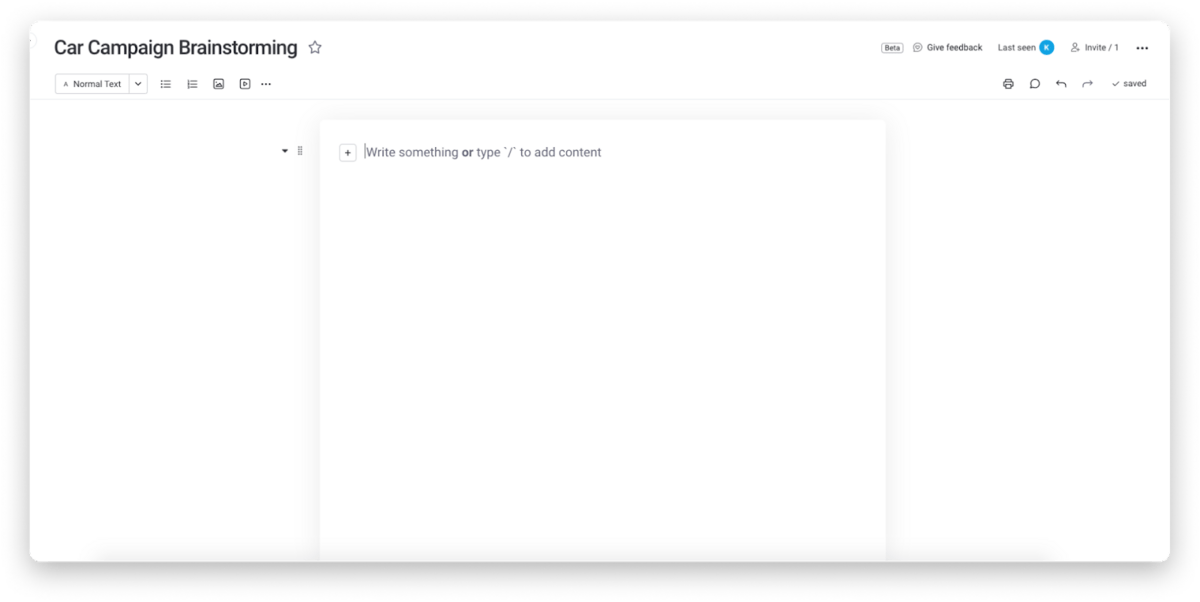
monday.com workdocs are “multimedia whiteboards” where you and your team can record notes related to a central topic.
You can also create multiple document types, including:
- Main documents: documentation that’s available for anyone in your organization
- Private documents: information and documents that only specific people can access
- Shareable documents: documents you can share with people outside your organization, like customers and stakeholders
monday.com workdocs are fully customizable and you can use them to create any type of document.
6. Integrations
Modern organizations rely on a wide range of apps and software.
In 2020, the average business used 80 different SaaS applications.
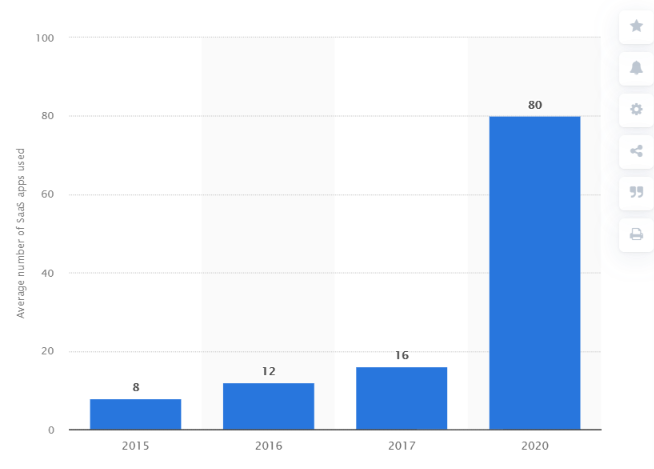
To deal with this increasing number of platforms, you need a DMS that helps you integrate your critical apps into the same space.
Seamlessly integrate over 40 of your favorite tools and apps on monday.com including:
- Google Drive
- Dropbox
- Slack
- Excel
- Zoom
- Gmail
- Adobe Creative Cloud
And many others.
This will not only help you reduce chaos and dispersed information, but also reduce the number of critical apps in your business.
7. Project management
To get the most out of document management, you should approach it like a project.
By setting specific goals, milestones, and deliverables with clear deadlines, you’re able to work more efficiently and manage your resources with precision.
Before choosing a specific document management solution, make sure it offers powerful project management functionality.
monday.com provides you with multiple project management features that will help you organize your work and manage your team with ease, including:
- Team management: assign team responsibilities, centralize your communication, and manage your entire team in the same place
- Data visualizations: visualize your workflows from different angles and perspectives, including Kanban, Timeline, Gantt, Workload, and more
- Collaboration features: communicate in context and chat with teammates in real-time
- Customizations: customize the entire platform to fit your exact project management needs
- Effective tracking and reporting: oversee your progress and get access to valuable insights about your performance
These features will help you organize your document management workflows more effectively and achieve your goals faster.
How to choose the right document management system for your organization
At this point, you already know some of the features you should look for when selecting a document management system (DMS) for your business.
So let’s quickly explore why monday.com makes sense for document management and how it can help you optimize your workflows faster.
What is monday.com?
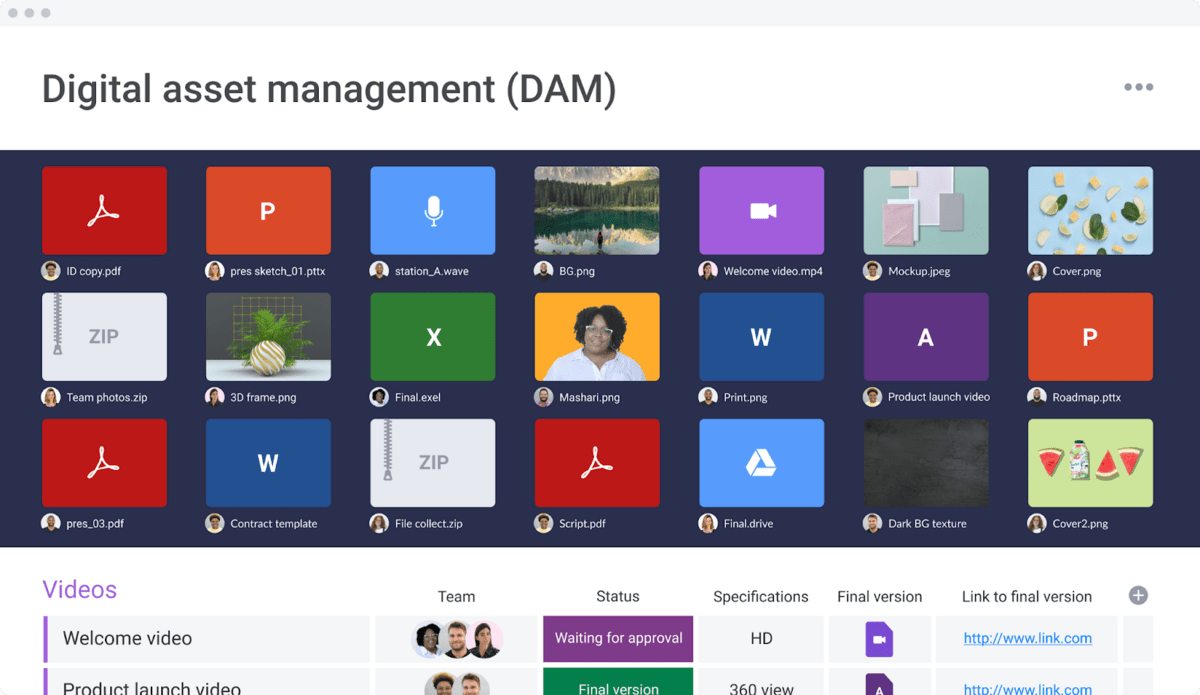
monday.com is more than just a document management solution. Of course, monday.com offers powerful features to manage your documents, but that’s barely scratching the surface.
To be precise, monday.com is a powerful Work OS where teams can design custom digital workspaces for any type of process or workflow, including: CRM, project management, software development, HR, and of course, document management.
With dozens of building blocks you can arrange at will, you can design a workspace that fits your exact needs with speed.
Why does monday.com make sense for document management?
In terms of electronic document management, monday.com offers valuable features, including:
- Robust storing: store up to 1,000 GB worth of information and organize your documents more efficiently
- 40+ integrations: integrate your favorite tools and apps in just a couple of clicks
- 250,000 automations: build custom automation recipes and streamline all your workflows
- File sharing: share files with specific team members or stakeholders with ease
- Collaboration features: centralize your communications and collaborate with your team faster
- Docs: create, share, and edit documents with our built-in document production features
- Project management: manage your document management projects from start to finish
To get a more complete understanding of all our document management functionality, we suggest you read our product overview page.
Your turn
Now that you understand how to design and optimize a document management workflow, it’s time to put that information into practice.
By following the 7 ideas outlined in this guide, you’ll be able to manage your most crucial information with more efficiency.
Besides, with monday.com’s powerful document management features, starting is pretty straightforward.
Why don’t you check out our digital asset management template? It’s fully customizable, and you can adapt it to fit your exact needs.
Get started
